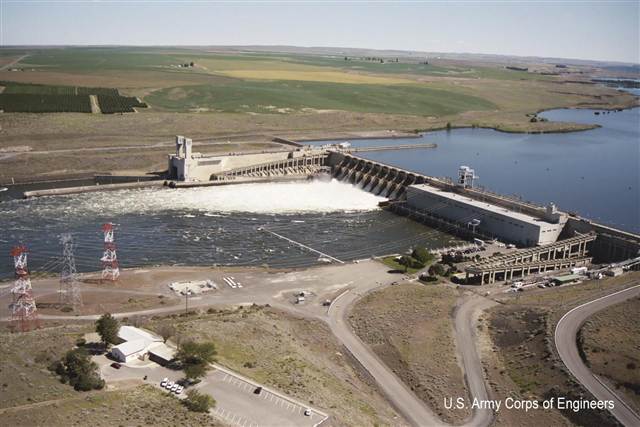forum
library
tutorial
contact

Making Turbines Safer for Fish
by StaffBPA Journal, October 2014
|
the film forum library tutorial contact |

|
Making Turbines Safer for Fishby StaffBPA Journal, October 2014 |
 When infrastructure is built to stand the test of time,
the chance for a do-over may only roll around every half century or so. And every opportunity counts in the regional effort to restore vibrant salmon runs in the Columbia River Basin. That's why three federal agencies are leading a project to improve the design of hydroelectric turbines in Northwest dams to make them friendlier to future generations of fish.
When infrastructure is built to stand the test of time,
the chance for a do-over may only roll around every half century or so. And every opportunity counts in the regional effort to restore vibrant salmon runs in the Columbia River Basin. That's why three federal agencies are leading a project to improve the design of hydroelectric turbines in Northwest dams to make them friendlier to future generations of fish.
With a trio of 1961-vintage hydroelectric turbines approaching the end of their useful life at Ice Harbor Lock and Dam in 2008, BPA and the U.S. Army Corps of Engineers recognized a window of opportunity. Ice Harbor Dam, on the Snake River near Pasco, Wash., has proven to be a fruitful site for developing technical innovations aimed at raising survival rates of endangered and threatened fish in the region.
Private and government biological and engineering experts are working together on the Ice Harbor project, which is unique because it elevates fish passage improvements to the highest goal, ahead of power and turbine efficiency gains. The turbines are also expected to be more efficient at generating electricity, providing 3 to 4 percent more power from the same volume of water. If they achieve their promise, the new turbines could be available for other Corps dams on the Columbia and Snake Rivers.
Engineer George Brown of BPA called the work an "excellent example of collaboration among BPA, the Corps, NOAA and a capable contractor."
"The key ingredient holding us all together is the goal of creating meaningful improvements to the environmental performance of a critical Northwest power resource," Brown says. "The efficiency and reliability benefits to the hydroelectric system are an important bonus, stretching the value of the limited water resource."
The Corps awarded a $10.9 million contract in 2010 for two turbines, the first in the next generation of advanced equipment that could provide safer passage for young salmon and steelhead migrating to the Pacific Ocean. BPA is funding the project, like other power-related investments in the 31 dams of the Federal Columbia River Power System, through its regional ratepayers. Voith Hydro Inc. of York, Pa., is designing and building the major components, including the runner, the part of the turbine that spins with the force of the river to generate power. This spring, the federal agencies decided to fund a third new turbine runner at Ice Harbor, expected to be in operation after 2020.
"The emphasis had been to keep fish out of the turbines, with the thought that the blades are really, really bad for fish," said Kevin Crum, turbine project manager at the Walla Walla District of the Corps. "But we're finding with new designs, they are not that bad -- we're actually seeing survival rates of 92 to 96 percent."
The Corps and BPA crafted the contract as a model to demonstrate a science-based turbine design and development process that could guide replacement of other turbines around the Columbia River Basin. Scott Bettin of BPA's Fish and Wildlife division says building a safer turbine was just the next logical step in a sequence of major improvements to fish passage in the FCRPS in recent years.
"There's three ways fish can get around a dam," Bettin explains. "We installed bypass systems and improved the effectiveness of spill with surface routes. Now we're replacing the turbines with state-of-the-art designs to improve survival through this route."
The project partners have been through multiple design cycles over the past three years, using advanced computer modeling as well as tests with physical models to examine water flow and pressures. With a diameter of 23 feet, the turbines may appear to resemble a giant water wheel, but the project team resists the notion it is re-inventing the wheel.
"The basic principles of the turbine haven't changed, and to a casual observer our improvements probably would not be very obvious," Crum says. "However, the cumulative effects of the hundreds and hundreds of design tweaks we've made result in substantial flow and efficiency improvements through the turbines."
Ahmann adds, "It's the design tools and process that are high-tech, not the turbine itself. But by making these subtle changes, we hope to make big improvements for fish."
"In addition to providing some much-needed turbines at Ice Harbor," he says, "this R&D effort has provided essential information that will help us make smart and responsible decisions in the future when it comes time to replace the federal turbine fleet in the Northwest."
learn more on topics covered in the film
see the video
read the script
learn the songs
discussion forum
